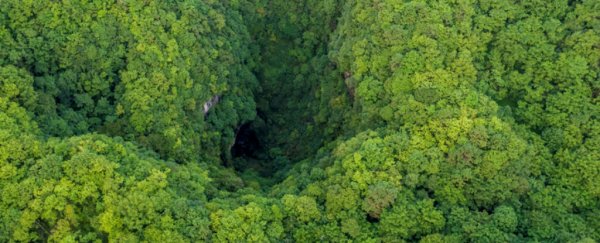Sinkholes are like Earth's way of reminding us that no matter how smart we get, it can always mess with us by taking the ground out beneath our feet without a moment's notice.
While human-caused sinkholes - like the one that just reopened in Japan - have been wreaking havoc on our cities of late, natural sinkholes are far more rare. But researchers in China have just uncovered the largest cluster of natural sinkholes in the world, with 49 of them covering an area of more than 600 square kilometres.
According to reports from government officials in the Shaanxi province in northwest China, the collection of sinkholes was found during a recent survey of land around Hanzhong City.
These sinkholes - or tiankengs, as they're also known - run along a 200-km-long 'karst' landform belt in the Qinling-Bashan Mountains of southwest Shaanxi.
Karst landforms are the result of soluble rocks such as limestone, dolomite, and gypsum dissipating, giving rise to subterranean drainage systems with sinkholes, caves, and tunnels.
After four months of exploration, covering a 5,000-square-kilometre area along the karst landform belt in Hanzhong City, an international team of geologists discovered a chain of 49 sinkholes and more than 50 funnels ranging from 50 to 100 metres (164-328 feet) in diameter.
The sink holes are reportedly spread over four counties in Hanzhong City: Ningqiang, Nanzheng, Xixiang and Zhenba.
The team, led by researchers at the Chinese Academy of Geological Science, found one enormous sinkhole, plus 17 large sinkholes, and 31 average-sized sinkholes.
To give you an idea of how big they were, the biggest sinkhole is deeper than the Eiffel Tower is tall, and its diameter is wider than the height of the Empire State Building.
"The largest one was in Zhenba, which had the largest diameter of 520 metres [1,706 feet] and a maximum depth of 320 metres [1049 feet]," Wang Weihua, chief of the Department of Land and Resources of Shaanxi, told China Daily.
Here's some footage taken of the sinkholes (plus an adorable cameo from a very colourful flying squirrel):
The investigation was also carried out by geologists from the UNESCO International Research Centre on Karst, the International Union of Speleology, and teams from institutions in the Czech Republic and France.
Their results have yet to be published, but the consensus is that this is the largest cluster of natural sinkholes found to date.
"The expert panel agreed, the Hanzhong tiankeng cluster is rare, complete, and spectacular in landscape. It has met international geological standards, and has potential scientific and tourism value," Weihua told the local Xinhua news agency.
It doesn't matter how good we are at exploring - Earth is still really great at hiding even the most enormous things from us.
